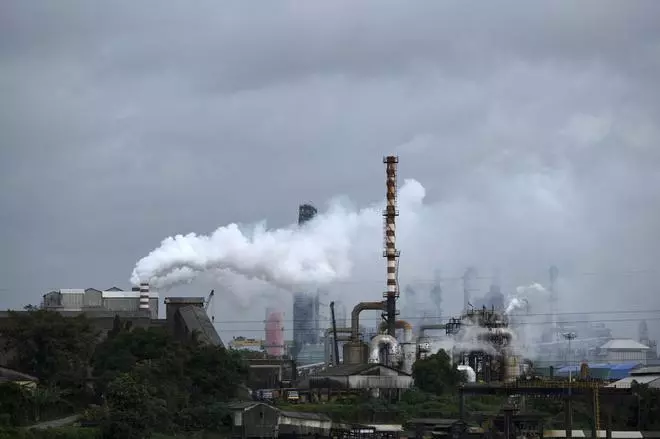Carbon sequestration is the process of capturing carbon dioxide, a greenhouse gas, released into the atmosphere and storing it away safely in solid or liquid form. The sequestration can be through natural and artificial processes. It reduces global warming and helps mitigate climate change.
Nature’s way of carbon sequestration and maintaining CO2 balance is through forests, vegetation and the oceans. Plants on the land as well as in the sea absorb CO2 and produce nutrition through photosynthesis and release oxygen as a byproduct. About 45 per cent of the CO2 in the atmosphere is thus naturally sequestered.

FILE - Steam emits from a crude oil refinery in Kochi, Kerala state, India, on Aug. 26, 2022. A new accounting of carbon dioxide emissions finds that heat-trapping gas pollution from fossil fuels went up about 1% more than last year. Researchers say efforts to remove carbon dioxide from the atmosphere aren't being scaled up fast enough and can’t be relied on to meet crucial climate goals. A report published Thursday by scientists in Europe and the United States found that new methods of CO2 removal currently account for only 0.1% of the 2 billion metric tons sucked from the atmosphere each year. (AP Photo/R S Iyer, File) | Photo Credit: R S Iyer
However, this natural balance has been disturbed by large-scale deforestation, land use and fossil fuel consumption. While afforestation is being prioritised and efforts are on to reduce fossil fuel dependency, artificial carbon sequestration through technology is being seen as a way to augment nature’s effort.
One method recommended is carbon capture and storage (CSS). It is a geoengineering process where carbon dioxide is first separated from other gases contained in industrial emissions before these are released into the atmosphere. It is then compressed and transported to a location where it is safely isolated from the atmosphere for long-term storage.
The captured carbon dioxide can be stored in deep saline deposits, safe geological formations or stored in exhausted oil and gas reservoirs and the oceans. It could also be stored where it could be put to industrial use.
The Indian government is serious about promoting carbon sequestration. To this end, two National Centres of Excellence in Carbon Capture and Utilisation have been set up in Mumbai and Bengaluru with support from the Department of Science & Technology. India has substantial geological sequestration potential in its basaltic rocks, coal seams, depleted oil reserves, deep saline aquifers, and sedimentary basins.





Comments
Comments have to be in English, and in full sentences. They cannot be abusive or personal. Please abide by our community guidelines for posting your comments.
We have migrated to a new commenting platform. If you are already a registered user of TheHindu Businessline and logged in, you may continue to engage with our articles. If you do not have an account please register and login to post comments. Users can access their older comments by logging into their accounts on Vuukle.